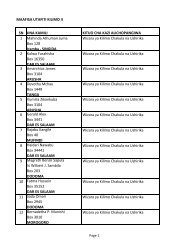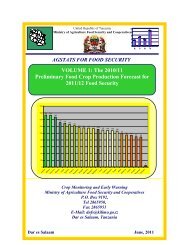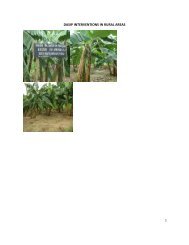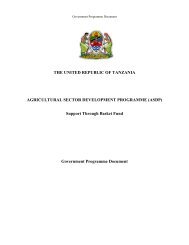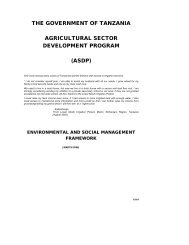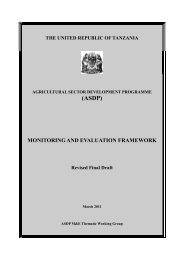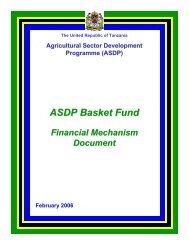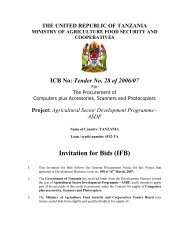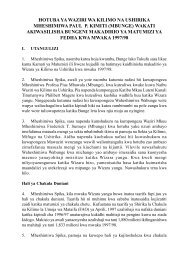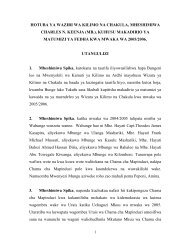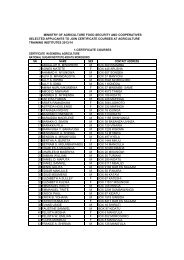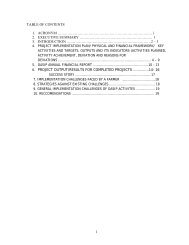Large Scale Farm Report - Ministry Of Agriculture, Food and ...
Large Scale Farm Report - Ministry Of Agriculture, Food and ...
Large Scale Farm Report - Ministry Of Agriculture, Food and ...
You also want an ePaper? Increase the reach of your titles
YUMPU automatically turns print PDFs into web optimized ePapers that Google loves.
REGIONAL PROFILES73Lindi has the lowest number of farms rearing livestock. It is one of the regions having the lowest number of cattle, goats,sheep <strong>and</strong> pigs. The number of improved cattle is relatively high. The region produces a small amount of milk <strong>and</strong> the farmgate price is much higher than any other region (except Dar es Salaam) indicating a high dem<strong>and</strong> over supply.Chicken production is not important in Lindi. There are no large scale farms in the region which qualifies to be a largescale farm due to chickens (ie having over 500).Lindi has the lowest number of farm employees. It has the lowest number of temporary farm employees <strong>and</strong> seventh lowestnumber of permanent farm employees. The number of male employees is higher than the number of female employees.4.8 TaboraTabora region has only 17 large scale farms with a l<strong>and</strong> area totaling 5,491 hectares under cultivation. It is characterised byannual cropping with a very small amount of permanent crops. The percent of l<strong>and</strong> available for large scale farms that wasutilised during the census year is one of the lowest in the country. Also, it is one of the regions having a small area of cropsper farm in Tanzania. The region has only one planting season (the long rainy season).Tabora has the fourth largest planted area of maize <strong>and</strong> sorghum in the country. It is a predominant tobacco growing region<strong>and</strong> has the largest planted areas of groundnuts in the country. Cassava, beans, cotton, paddy, sunflowers are of moderateto low importance in the region. Permanent crops consist of small areas of sugar cane, palm oil, mangoes, oranges <strong>and</strong>banana.The region has a small planted area under irrigation. Dams <strong>and</strong> bore holes are the most common source of water forirrigation. Water for irrigation is commonly obtained through gravity <strong>and</strong> motor pumps. A high percent of large scalefarms received extension services in Tabora compared to other regions. A moderate number of trees planted are by largescale farms in the region <strong>and</strong> a small number of farms practiced erosion control or have water harvesting structures.Tabora has a low livestock population on large scale farms. The region has a small number of farms rearing cattle, goats,sheep <strong>and</strong> pigs. Also, it has low number of cattle, goats, sheep <strong>and</strong> pigs. The number of improved livestock is also small,the quantity of milk produced per day is small <strong>and</strong> the farm gate price is average for the country. The number of chicken issmall; hence, the number of eggs produced per day is also small.Tabora has a fourth highest incidence of Coccidiosis infection in the country. However, the infection rate of most otherdiseases is moderate to low. Access to secondary markets <strong>and</strong> hides <strong>and</strong> skin sheds is moderate while access to veterinaryservices, primary market <strong>and</strong> input supply is worse. Tabora has small number of farms receiving extension services onlivestock.Tabora is one of the regions with lowest number of farm employees, both permanent <strong>and</strong> temporary employees.4.9 KigomaKigoma region has 34 large scale farms with a l<strong>and</strong> area totaling 4,980 hectares under crop production <strong>and</strong> it has smallnumber of crop growing large scale farms compared to other regions with the majority being crop only growing farms. Thel<strong>and</strong> area utilized per large scale farms is 513 hectares <strong>and</strong> it has a high rate of utilization compared to the total l<strong>and</strong>Tanzania <strong>Agriculture</strong> Sample Census – 2003



